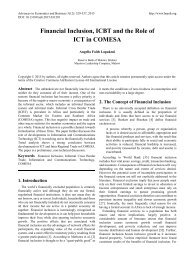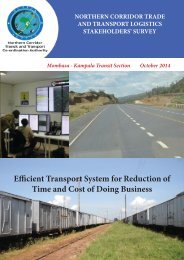FD
gvti301SEaf
gvti301SEaf
You also want an ePaper? Increase the reach of your titles
YUMPU automatically turns print PDFs into web optimized ePapers that Google loves.
Employees do paperwork at the brokerage house of Merrill Lynch, Pierce,<br />
Fenner & Smith, New York, United States,1965.<br />
The newsroom in the Washington Post’s new building<br />
in Washington, D.C., United States, 2016.<br />
To translate projected growth in output per hour to output<br />
per person, 0.4 percentage point is deducted annually,<br />
mainly to account for the retirement of the baby-boom generation.<br />
This results in a 2015–40 forecast for output per<br />
person of 0.80 percent a year, contrasting with the historical<br />
rate of 2.11 percent a year. To get to median income per<br />
person, another 0.40 percentage point a year is subtracted<br />
to reflect a continued rise in inequality at roughly the same<br />
rate experienced from 1975 to 2014. An additional subtraction<br />
of 0.1 percentage point is made for anticipated cuts in<br />
social Gordon, benefits corrected 04/11/2016 or increases in Social Security and Medicare<br />
taxes that will be needed to counteract the upward creep in<br />
the federal debt-to-GDP ratio because of an aging population.<br />
The resulting forecast for 0.3 percent annual growth in<br />
per capita disposable median income (that is, the amount<br />
Chart 5<br />
Future shock<br />
By a variety of measures of real income, growth will be<br />
substantially slower in the coming quarter-century than in<br />
the preceding 95 years.<br />
(annual growth rate, percent)<br />
3<br />
2.26<br />
2.11<br />
1920–2014<br />
2015–40<br />
2<br />
1.82<br />
1.69<br />
1.20<br />
1<br />
0.8<br />
0.4 0.3<br />
0<br />
Output per hour Output Median income Disposable<br />
per person per person median income<br />
per person<br />
Source: Gordon (2016).<br />
Note: Data for 1920 through 2014 are actual; from 2015 to 2040 data are projected. To<br />
translate output per hour to output per person 0.4 percentage point is subtracted to reflect<br />
the larger number of nonworking people, largely the result of baby boomer retirement. In<br />
calculating median income per person, another 0.4 percentage point is deducted to reflect<br />
the effects of continued rising inequality. To calculate median disposable income another<br />
0.1 percentage point is deducted to account for anticipated cuts in social benefits or<br />
increases in taxes to support them.<br />
of total income that can be spent) contrasts with the rate of<br />
1.69 percent a year achieved from 1920 to 2014.<br />
While the forecasts may appear pessimistic, they do not<br />
countenance an end to innovation and technical change.<br />
On the contrary, the prediction of 1.20 percent productivity<br />
growth is very similar to 1970–94 and 2004–15. A compound<br />
1.2 percent growth rate would imply a level of labor productivity<br />
in the year 2040 that is 35 percent above that in 2015, and<br />
would be achieved by further innovations in robotics, artificial<br />
intelligence and big data, 3-D printing, and driverless vehicles.<br />
But while innovation continues, the median growth rate of<br />
real income per person will be less than productivity growth<br />
because of an aging of the population and rising inequality.<br />
Government policy can affect these impediments to median<br />
income growth. The best offset to the retirement of the babyboom<br />
generation is substantially increased immigration to<br />
lower the average age of the population and to raise the proportion<br />
that is working. A larger working population would<br />
raise tax revenue and counteract future increases in the<br />
debt-to-GDP ratio from the aging of the population. As for<br />
inequality, the government cannot prevent successful CEOs,<br />
entertainment stars, and entrepreneurs from earning high<br />
incomes, but it can use progressive taxation to redistribute<br />
income and promote more equality of after-tax incomes.<br />
Robert J. Gordon is the Stanley G. Harris Professor of the<br />
Social Sciences at Northwestern University.<br />
References:<br />
Davis, Stephen J., and John Haltiwanger, 2014, “Labor Market Fluidity<br />
and Economic Performance,” NBER Working Paper 20479 (Cambridge,<br />
Massachusetts: National Bureau of Economic Research).<br />
Gordon, Robert J., 2016, The Rise and Fall of American Growth:<br />
The U.S. Standard of Living since the Civil War (Princeton, New Jersey:<br />
Princeton University Press).<br />
Hortaçsu, Ali, and Chad Syverson, 2015, “The Ongoing Evolution<br />
of US Retail: A Format Tug-of-War,” NBER Working Paper 21464<br />
(Cambridge, Massachusetts: National Bureau of Economic Research).<br />
Finance & Development June 2016 37














